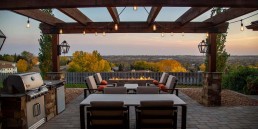
Designing and landscaping a garden is a great way to enhance the beauty of your outdoor space and add value to your property. Whether you are starting from scratch or revamping an existing garden, there are some dos and don’ts to keep in mind to ensure that your design and landscaping are successful.
DO: Consider the Climate and Microclimate
The first step in garden design is to consider the climate and microclimate of your area. This will help you choose the right plants and materials that can thrive in your garden. The climate refers to the overall weather patterns in your region, while the microclimate is the specific environmental conditions in your garden, such as the amount of sun exposure, wind, and soil quality.
DO: Set a Budget
Before starting your garden design and landscaping project, it’s important to set a budget. This will help you prioritize your expenses and prevent overspending. Decide how much money you want to allocate for plants, materials, and labor, and stick to it.
DO: Create a Focal Point
A focal point is a key element in garden design that draws the eye and adds interest to the space. This can be a statue, water feature, or a unique plant. Whatever you choose, make sure it fits with the overall design and style of your garden.

DO: Use Different Textures and Colours
Using a variety of textures and colours can add depth and interest to your garden design. Combining different textures, such as smooth stones and rough bark, can create a visually appealing contrast. Similarly, using a variety of colours can create a vibrant and lively garden.
DO: Incorporate Lighting
Adding lighting to your garden can create a magical atmosphere, especially at night. Consider installing outdoor lighting that highlights key features, such as a tree or water feature, or use string lights to create a cozy ambiance.
DON’T: Forget about Maintenance
While it’s important to create a beautiful garden, it’s equally important to consider the maintenance required to keep it looking good. Make sure you choose plants and materials that are easy to care for and fit your lifestyle. Additionally, consider the cost and time required for ongoing maintenance, such as watering, fertilizing, and pruning.
DON’T: Overcrowd Plants
It’s easy to get carried away and want to fill your garden with as many plants as possible, but overcrowding can be detrimental to their growth and health. Make sure you give each plant enough space to grow and thrive, and consider their mature size when planting.
DON’T: Ignore the Seasons
When planning your garden design, it’s important to consider the changing seasons. Choose plants that bloom at different times of the year to ensure that your garden looks beautiful year-round. Additionally, consider how the sunlight and temperature change throughout the year and adjust your design accordingly.
DON’T: Neglect the Environment
Gardening is a great way to connect with nature, but it’s important to be mindful of the impact your garden has on the environment. Avoid using harmful chemicals and pesticides, choose plants that are native to your region, and consider installing a rain barrel to collect water for your garden.
DO: Hire a Professional
If you are not confident in your gardening skills or have a complex design in mind, consider hiring a professional landscaper or garden designer. They can provide expert advice and ensure that your garden design and landscaping are successful.
In conclusion, designing and landscaping a garden can be a rewarding and enjoyable experience, but it’s important to keep these dos and don’ts in mind. By considering the climate, setting a budget, creating a focal point, using different textures and colours, incorporating lighting, avoiding overcrowding plants, considering the seasons, and being mindful of the environment, you can create a beautiful and sustainable garden that you can enjoy for years to come.
